|
|
|||
|
(Back to Preceding Week; on to Next Week) |
|
Blue-throated |
Weeks One is full and Week Three has only one slot remaining for our annual |
Canivet's |
|
RUBY-THROATS OF 2008: We give up on Ruby-throated Hummingbirds at Hilton Pond Center. No, we're not going to quit feeding, observing, and banding them, but we're about ready to say we will never again make a prediction about how many we'll capture by the end of a given banding season. Why this hesitation? Mostly because 2008 started out as one of our slowest springs ever for banding ruby-throats at the Center and things got even worse, with only SEVEN hummers banded through 30 June. We were almost despondent over this obvious lack of Ruby-throated Hummingbirds and predicted 2008 would end as one of our worst years--a prediction supported by folks from across the Southeast who also reported unusually low numbers of ruby-throats. Eventually, hummingbirds--as they usually do--began to appear during the first week in July but continued showing up at only an average pace until late August. Then the population exploded and we could hardly keep up with all the hummers in our nets and traps. In the end, 2008 turned out to be our BEST year ever, not our worst. So where did all these late summer and early autumn birds (finally) come from? All text, charts, tables & photos © Hilton Pond Center Chart 1: Click on chart above to open a larger image in a new browser window The season started with the arrival of an unbanded adult male on 9 April 2008 (see red line on Chart 1 above), almost two weeks after our early banding record of 27 March 1991; most years we band our first Ruby-throated Hummingbird (RTHU) at Hilton Pond Center on or before 10 April--which happened to be the date of our second banding in 2008. After that progress was excruciatingly slow with NO new birds at all in May and only one returning bird on 30 May. The next new RTHU was on 2 June, and we ended up with only five new birds for that entire month. As Chart 1 shows, things finally began improving in early July, with a substantial number of new birds appearing in mid-September. The final capture occurred on 9 October, a little later than our average late date for the last RTHU of the season--but earlier than our record of 18 October set 'way back in 1986. All text, charts, tables & photos © Hilton Pond Center Chart 2: Click on chart above to open a larger image in a new browser window The spaghetti-like lines on Chart 1 depict how banding progressed through the 2008 hummingbird season, but it's easier to see how successful we were this year by looking at the bar graph in Chart 2 just above. As shown, our previous best year was three years ago (2005) when we banded 226 RTHU. For some reason there was a big drop in 2006 with only 164 hummers captured, but the Hilton Pond population--which includes both breeding birds and spring and fall migrants--rebounded nicely in 2007 to our fourth-best total of 204 birds. This year trumped them all, with 230 RTHU banded--well above our 19-year average of 173.4. (NOTE: This figure does not include six partial field seasons for which we were away from Hilton Pond for significant portions of the summer.) If we can trust the red trend line on Chart 2 above, Ruby-throated Hummingbirds appear to be on the increase at Hilton Pond Center. We doubt the upward curve is a result of our becoming more experienced at catching hummers, nor does it reflect more hours of trapping and mist netting.
All text, charts, tables & photos © Hilton Pond Center As each hummingbird banding season ends, it's always interesting to look at the breakdown among age/sex classes as illustrated in Table 1 (above). Most years adult females outnumber adult males by about a 3:2 margin, while the ratio flips among young birds so that fledgling males outnumber young females. Adults varied from this trend in 2008, primarily because we banded an above-average number of adult females (39) while capturing a below-average number of adult males (20), giving a 2:1 ratio. Among juvenile RTHU, males were much more plentiful than usual (70% compared to the 19-year average of 60%), mostly because our 118 hatch-year males banded blew the previous record by ten individuals--and even though our 53 young females in 2008 were above average. Had all age classes been banded at the same rate as young males, we might have approached 300 RTHU for the year at Hilton Pond Center. Along with setting a record high with 230 new Ruby-throated Hummingbirds banded in 2008 at Hilton Pond, we also did quite well on returning birds from previous years. On average we have about 26 "old" birds coming back; in 2008 we tallied 38 of them--second only to the whopping 49 we had in 2007. Those 38 individuals returning this year are listed in Table 2 below, showing the banding date and when each was recaptured in 2008, as well as its age at banding and recapture and any previous returns. (We won't apologize that the list is long; in fact, we're excited it is!)
All text, charts, tables & photos © Hilton Pond Center Banding Ruby-throated Hummingbirds provides interesting data, but RECAPTURING them tells us much more--even if the birds aren't encountered long distances away from the banding site. Thus, we'd like to point out a few things in Table 2 (above) that should be of interest to the hummingbird enthusiast, especially when we include additional results from Table 3 (below).
All text, charts, tables & photos © Hilton Pond Center Among other things of interest about Ruby-throated Hummingbirds returning to Hilton Pond Center in 2008:
As usual for our end-of season hummingbird report, we've shown you a bunch of numbers. That's about the only way we know to present information summarizing our annual hummer banding results, so we'll end up with the photo below of an adult male Ruby-throated Hummingbird that hung around until mid-October before departing for the Neotropics.
All text, charts, tables & photos © Hilton Pond Center This bird was color-marked with temporary green dye on its breast--a sure sign it was banded at Hilton Pond Center. We color mark so we don't pull the string and re-trap the same hummers over and over again, but we band so we can better understand migration, longevity, and site fidelity. However, neither our banding scheme or our color marking strategy completely answer that question we asked at the beginning of this essay: After such a slow start in 2008, where did all these late summer and early autumn hummers (finally) come from? Although we suspect few were locally produced, the question will go unanswered. This is because we've never caught a Ruby-throated Hummingbird banded elsewhere by someone else--and we're not REALLY giving up on Hilton Pond hummingbirds until we do.
Comments or questions about this week's installment?
Thanks to the following fine folks for recent gifts in support of Hilton Pond Center for Piedmont Natural History and/or Operation RubyThroat: The Hummingbird Project. Your tax-deductible contributions allow us to continue writing, photographing, and sharing "This Week at Hilton Pond." (Please see Support if you'd like to make a gift of your own.)
"This Week at Hilton Pond" is written & photographed You may wish to consult our Index of all nature topics covered since February 2000. You can also use our on-line Hilton Pond Search Engine at the bottom of this page. For a free, non-fattening, on-line subscription to |
||||||||||||||||||||||||||||||||||||||||||||||||||||||||||||||||||||||||||||||||||||||||||||||||||||||||||||||||||||||||||||||||||||||||||||||||||||||||||||||||||||||||||||||||||||||||||||||||||||||||||||||||||||||||||||||||||||||||||||||||||||||||||||||||||||||||||||||||||||||||||||||||||||||
|
Make direct donations on-line via
Network for Good: |
|
|
Use your PayPal account
to make direct donations: |
|
|
If you like to shop on-line, you please become a member of iGive, through which more than 750 on-line stores from Barnes & Noble to Lands' End will donate a percentage of your purchase price in support of Hilton Pond Center and Operation RubyThroat. For every new member who signs up and makes an on-line purchase iGive will donate an ADDITIONAL $5 to the Center. Please sign up by going to the iGive Web site; more than 200 members have signed up to help. It's a painless, important way for YOU to support our work in conservation, education, and research. |
|
| The highly coveted Operation RubyThroat T-shirt (four-color silk-screened) is made of top-quality 100% white cotton. It highlights the Operation RubyThroat logo on the front and the project's Web address (www.rubythroat.org) across the back.
Now you can wear this unique shirt AND help support Operation RubyThroat: The Hummingbird Project and Hilton Pond Center. Be sure to let us know your mailing address and adult shirt size: Small (suitable for children), Medium, Large, X-Large, or XX-Large. These quality shirts don't shrink! Price ($21.50) includes U.S. shipping. A major gift of $1,000 gets you two Special Edition T-shirts with "Major Donor" on the sleeve. |
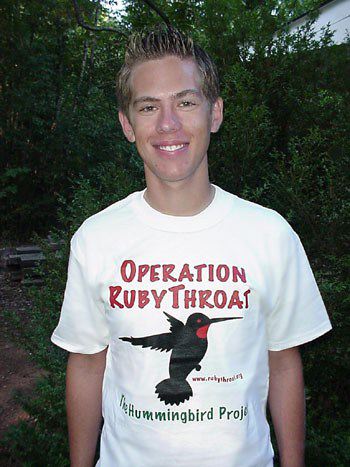
Need a Special Gift for a Want to make a If so, why not use our new handy-dandy on-line Google Checkout below to place your secure credit card order or become a Major Donor today? |
|
|
|
|
SPECIES BANDED THIS WEEK: * = New species for 2008 WEEKLY BANDING TOTAL 1 species 9 individuals YEARLY BANDING TOTAL (2008) 64 species 1,642 individuals 27-YEAR BANDING GRAND TOTAL (since 28 June 1982) 124 species 51,809 individuals NOTABLE RECAPTURES THIS WEEK (with original banding date, sex, and current age) None this week All text & photos © Hilton Pond Center
|
OTHER NATURE NOTES OF INTEREST
|
|
PERSONAL NOTE
Thanks to community support, police have arrested one of two suspects. Woody is still battling for his life at Virginia Commonwealth University medical center and has been through numerous surgeries and procedures. As much as it pains us to gaze at the photo of Woody in his Intensive Care Unit hospital bed (image courtesy Woody's brother Greg), we take solace in seeing a glimmer of a smile and some sparkle in his eyes. If you know Woody--and even if you don't--please take a moment to send healing vibes his way in the hope his recovery will be swift and complete. |
|
|
|
|
(Back to Preceding Week; on to Next Week) Up to Top of Page Back to This Week at Hilton Pond Center Current Weather Conditions at Hilton Pond Center |
 You can also post questions for The Piedmont Naturalist |
Join the |
Search Engine for |
|
|
Cordless Phones

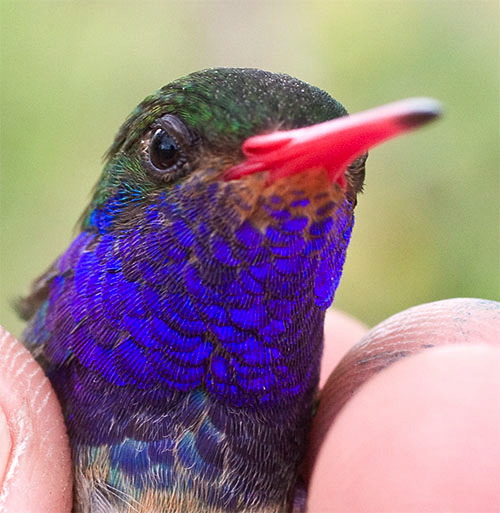
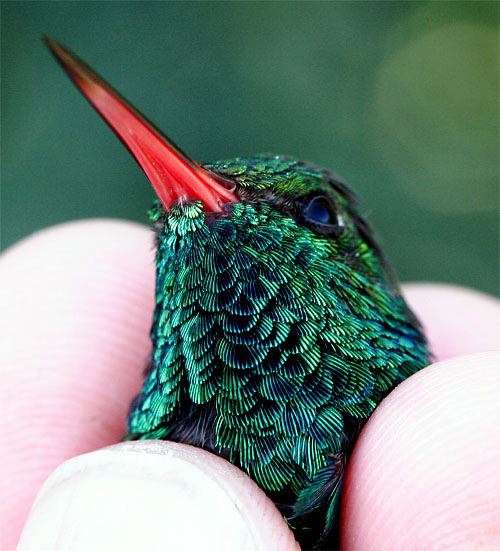
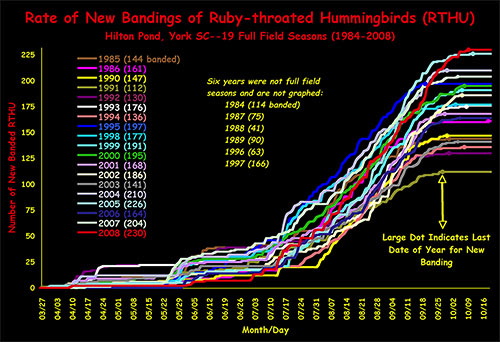
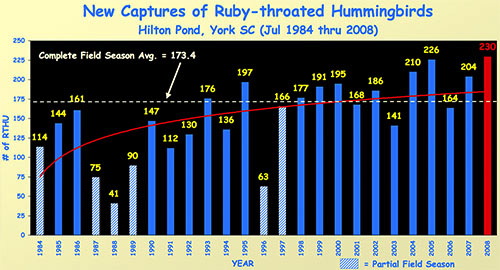
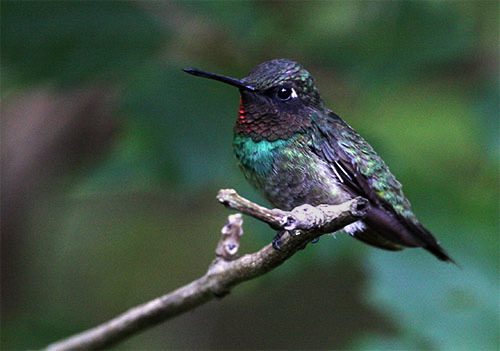


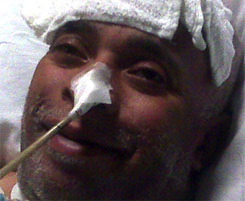 Our dear and lifelong friend, Haywood Daniel McCallum Jr., was shot several times and wounded severely by robbers outside his home in Richmond VA on the evening of 11 October 2008. We have known kind-hearted Woody, a gifted and widely admired music teacher retired from Richmond schools, for almost 40 years--ever since 1969 when we were on "staph" and he was a delegate to West Virginia's prestigious National Youth Science Camp.
Our dear and lifelong friend, Haywood Daniel McCallum Jr., was shot several times and wounded severely by robbers outside his home in Richmond VA on the evening of 11 October 2008. We have known kind-hearted Woody, a gifted and widely admired music teacher retired from Richmond schools, for almost 40 years--ever since 1969 when we were on "staph" and he was a delegate to West Virginia's prestigious National Youth Science Camp. Oct 15 to Mar 15:
Oct 15 to Mar 15: